Looking for the top places to visit in Tirupati? Look no further! Our guide takes you through the 10 must-see destinations in this cultural and religious hub of India. From the world-famous Tirumala Venkateswara Temple to the stunning Chandragiri Fort, there’s something for everyone in Tirupati. Whether you’re a devout Hindu seeking spiritual solace or a history buff fascinated by ancient architecture, you’ll find plenty to explore in this magnificent city. So pack your bags and get ready to embark on a journey to the top 10 places to visit in Tirupati. Don’t miss out on this unforgettable experience!
Tirupati is a city located in the state of Andhra Pradesh in southern India. It is famous for the Sri Venkateswara Temple, a Hindu temple dedicated to Lord Venkateswara, an incarnation of Sri Maha Vishnu. The temple is located on the seven hills of Tirumala, which is a part of the Seshachalam Hills. The temple is one of the most visited pilgrimage sites in the world, with millions of devotees visiting every year. The city of Tirupati also has many other temples and places of historical and cultural significance, including the Sri Kapileswara Swamy Temple, the ISKCON temple, the Sri Venkateswara Zoological Park, and the Chandragiri Fort. It is also known for its delicious cuisine, especially its sweets and savories, which are popular all over the country. Below are the Top 10 Places to Visit in Tirupati.
Table of Contents
- Sri Padmavathi Ammavari Temple / Alamelu Mangapuram
- Sri Kalyana Venkateswara Swamy Temple
- Talakona Waterfall
- Sri Kapileswara Swamy Temple
- Sri Govindaraja Swamy Temple
- ISKCON Tirupati
- Vakula Matha Temple
- Chandragiri Fort and Palace
- Sri Venkateswara Zoological Park
- Regional Science Centre
1) Sri Padmavathi Ammavari Temple / Alamelu Mangapuram
The ancient legends of Tirupati and Tirumala are steeped in spirituality and mythology. According to one popular belief, Goddess Lakshmi was born as Alamelu to Akasha Raja, the ruler of the region. She later wed Sri Venkateshwara Swamy of Tirupati. It is said that after his deep penance for twelve years, Goddess Lakshmi gave darshan to Lord Venkateswara on a red Lotus flower, known as Padma in Sanskrit, at Alamelu Mangapuram.
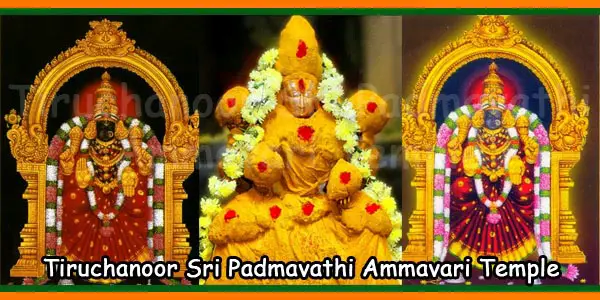
As per tradition, the Mother Goddess manifested herself in the holy Pushkarini called Padmasarovaram, in a golden lotus. The Venkatachala Mahatyam states that Lord Suryanarayana was instrumental in the blossoming of the lotus in full splendor. On the eastern side of the Pushkarini, there is a temple dedicated to Lord Suryanarayana. The Padma Purana gives a vivid description of the advent of the Goddess and Her subsequent wedding with Lord Srinivasa.
The manifestation of Sri Padmavathi Devi occurred in the month of Karthika on Sukla Paksha Panchami when the star Uttarashada was in the ascendant. The Brahmotsavam of the Goddess is celebrated with all pomp and glory to commemorate the auspicious occasion of her avatara. Such is the rich history and mythology surrounding the holy sites of Tirupati and Tirumala.
Padmavathi, also known as Alamelumanga, is the primary deity of the temple and is believed to be the incarnation of goddess Lakshmi, the consort of Lord Venkateswara. The deity is facing towards the east, and devotees come from far and wide to offer their prayers and seek blessings.
Tirupati Tirumala Balaji Temple Darshan Timings: 3:00 AM to 1:00 AM
Padmasarovaram (the temple tank)
Padmasarovaram is the temple tank of Sri Padmavathi Temple and is a significant part of the holy pilgrimage to Tirumala. According to legend, it is believed that Goddess Padmavathi manifested herself in this tank in the form of a golden lotus flower on ‘Sukla Paksha Panchami’ day in the Kartheeka masam.
Temple Festivals
Chakra Snanam is an essential ritual held in Padmasarovaram on the last day of the Annual Padmavathi Brahmotsavams, known as Panchami Teertham. This sacred event witnesses lakhs of devotees taking a dip in the holy waters to cleanse their sins and seek blessings from the divine Goddess. The ritual is believed to have immense significance in purifying the soul and bringing peace and prosperity to one’s life.
Other Temples
The Padmavathi Temple complex also houses two sub-temples, namely Sri Krishna Swamy Temple and Sri Sundararaja Swamy Temple. The former is the oldest of the temples and is believed to have been constructed in the year 1221 AD, as per evidence. On the other hand, Sri Sundararaja Swamy Temple is a relatively newer temple that came into existence in the 16th century. It is dedicated to Sri Varadaraja Swamy and his consorts Sridevi and Bhudevi.
Apart from these two temples, there is also a temple dedicated to Lord Suryanarayana, situated opposite to Padmasarovaram, the temple tank. This temple is believed to have been installed by Lord Venkateswara himself and is an important part of the holy pilgrimage to Tirumala. The temple is considered to be a sacred place of worship and is visited by numerous devotees seeking blessings from the divine Lord.
Daily Programme (except on Fridays)
Suprabhatam: 5:00 AM
Sahasranama Archana and Nitya Archana: 5:30 AM
Sarvadarsanam: 7:00 AM to 6:30 PM and 7:30 PM to 9:00 PM
Kalyanotsavam: 10:30 AM to 12:00 Noon
Unjal Seva 5:00 PM to 6:00 PM
Ekanta Seva: 9:00 PM
Ashtadala Padapadmaradhana Seva (Every Monday): 6:30 AM to 7:00 AM
On Friday:
Suprabhatam: 3:30 AM
Sahasranamarchana and Nitya Archana 4:00 AM
Abhishekam: 5:00 AM to 6:30 AM
Sarvadarsanam: 9:30 AM to 7:30 PM and 8:30 PM to 9:30 PM
Kalyanotsavam: 10:30 AM to 12:00 Noon
Unjal Seva: 6:00 PM to 7:00 PM
Ekantha Seva: 9:00 PM
2) Sri Kalyana Venkateswara Swamy Temple
The Sri Kalyana Venkateswara Swamy Temple is a Hindu temple located in the town of Srinivasa Mangapuram, in the Chittoor district of Andhra Pradesh, India. This temple is dedicated to Lord Venkateswara, an incarnation of Lord Vishnu, and is considered to be one of the most important pilgrimage sites in South India. In this article, we’ll explore the history and significance of the Sri Kalyana Venkateswara Swamy Temple, as well as what visitors can expect when they visit this sacred site.
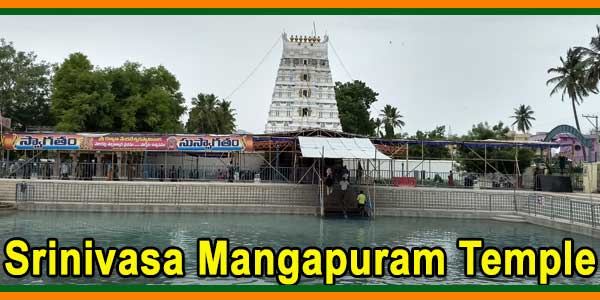
History of the Sri Kalyana Venkateswara Swamy Temple
According to legend, the Sri Kalyana Venkateswara Swamy Temple was built by a king named Thondaman Chakravarthi in the 12th century. The king was a devotee of Lord Venkateswara and wanted to build a temple dedicated to the deity. He asked his chief architect to find a suitable location for the temple, and the architect eventually found a place in Srinivasa Mangapuram.
Over the centuries, the temple underwent several renovations and additions, including the construction of the Rajagopuram, or main entrance tower, in the 16th century. The temple also played a significant role in the history of the Vijayanagara Empire, as it was used as a meeting place for the empire’s rulers and their advisors.
Significance of the Sri Kalyana Venkateswara Swamy Temple
The Sri Kalyana Venkateswara Swamy Temple is considered to be a highly auspicious site for Hindu pilgrims. The temple is dedicated to Lord Venkateswara, who is believed to be a form of Lord Vishnu and is associated with prosperity, happiness, and spiritual enlightenment.
The temple is also known for its association with the Hindu wedding ceremony. According to legend, Lord Venkateswara himself was married to Padmavathi, a princess from the nearby town of Tiruchanur. The temple’s name, “Kalyana Venkateswara,” means “the Venkateswara who blesses marriages,” and it is believed that couples who visit the temple and offer prayers to Lord Venkateswara will be blessed with a happy and successful marriage.
Visiting the Sri Kalyana Venkateswara Swamy Temple
The Sri Kalyana Venkateswara Swamy Temple is open to visitors every day from 6:00 am to 8:00 pm. Visitors are required to remove their shoes before entering the temple, and men are required to wear dhoti and Angavastram, while women are required to wear traditional Indian attire.
The temple complex includes several smaller shrines dedicated to other deities, as well as a large mandapam, or hall, where devotees can offer prayers and make offerings. The temple also has a large tank, known as the Kalyana Pushkarini, which is believed to have healing properties.
One of the most important festivals celebrated at the Sri Kalyana Venkateswara Swamy Temple is the annual Brahmotsavam, which takes place over nine days in the month of Vaisakha (April-May). During this festival, the temple is decorated with colorful lights and flowers, and thousands of pilgrims from all over the country come to offer their prayers and seek the blessings of Lord Venkateswara.
3) Talakona Waterfall
Talakona Waterfall is a natural wonder located in the Chittoor district of Andhra Pradesh, India. The waterfall is a popular tourist attraction, offering visitors a chance to witness the power and beauty of nature. In this article, we’ll provide you with a guide to timing, the best season to visit, price and facilities at Talakona Waterfall.

Talakona Timing
Talakona Waterfall is open to visitors from 9:00 am to 6:00 pm on all days of the week. The waterfall is busiest during weekends and holidays, so visitors may want to plan their trip accordingly. It is advisable to arrive early in the morning to avoid the crowds and enjoy the serene surroundings.
Talakona Best Season to Visit
The best time to visit Talakona Waterfall is during the monsoon season, which lasts from July to October. During this time, the waterfall is at its full glory, with water cascading down the rocky cliffs in a spectacular display of nature’s power. The surrounding forests are lush and green, and visitors can enjoy a refreshing dip in the cool waters of the stream.
Talakona Entry Fee
Visitors to this wonderful place can enjoy it for a mere Rs. 3 entry fee per person, with boating available for an additional Rs. 10 per person. Visitors can also hire a guide for the trek to the top of the waterfall, which costs Rs. 300 per group.
Talakona Facilities
Talakona Waterfall offers several facilities to visitors, including parking, restrooms, and a snack bar. Visitors can also rent camping equipment and tents if they wish to spend the night in the park. The park also has a forest department guest house, which can be booked in advance for overnight stays.
Trekking to the top of the waterfall is a popular activity among visitors. The trek is moderate and takes about an hour to reach the top. Visitors can enjoy stunning views of the surrounding landscape from the top of the waterfall. It is advisable to wear comfortable shoes and carry plenty of water and snacks for the trek.
4) Sri Kapileswara Swamy Temple
Sri Kapileswara Swamy Temple also known as Kapila Theertham is a revered Hindu temple located in the town of Tirupati, Andhra Pradesh. The temple is dedicated to Lord Shiva and is believed to be one of the oldest and most significant Shiva temples in the region. In this article, we’ll provide you with a guide to timing, festivals, poojas performed, and history at Sri Kapileswara Swamy Temple.
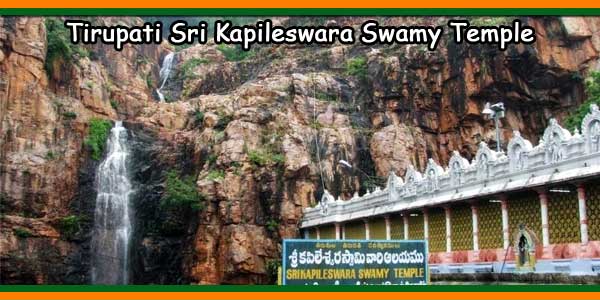
Kapila Theertham Timing
Sri Kapileswara Swamy Temple is open to visitors from 5:00 am to 8:00 pm on all days of the week. The temple is busiest during weekends and holidays, so visitors may want to plan their trip accordingly. It is advisable to arrive early in the morning to avoid the crowds and enjoy the serene surroundings.
Kapila Theertham Festivals
The temple celebrates several festivals throughout the year, with the most significant being Mahashivaratri, which is celebrated in February or March. During this festival, devotees offer prayers and perform poojas to Lord Shiva, seeking his blessings and divine grace. Other festivals celebrated at the temple include Ugadi, Diwali, and Navaratri.
Kapila TheerthamPoojas Performed
The temple offers several poojas to devotees, including Rudrabhishekam, Laghu Rudrabhishekam, and Maha Rudrabhishekam. These poojas are performed to seek blessings from Lord Shiva and are believed to bring peace, prosperity, and happiness to the devotees’ lives. The temple also offers several other poojas, including Abhishekam, Archana, and Sahasranamarchana.
Sri Kapileswara Swamy Temple History
According to legends, the temple was built during the rule of the Pallava dynasty in the 9th century. The temple’s name is derived from the fact that Lord Shiva is believed to have appeared before the sage Kapila at this site. The temple was later renovated during the reign of the Vijayanagara dynasty and has since undergone several renovations and additions.
5) Sri Govindaraja Swamy Temple
Sri Govindaraja Swamy Temple is one of the most popular pilgrimage sites in the town of Tirupati, Andhra Pradesh. The temple is dedicated to Lord Vishnu and attracts thousands of devotees every day. In this article, we’ll provide you with a guide to timing, festivals, poojas performed, and history at Sri Govindaraja Swamy Temple.
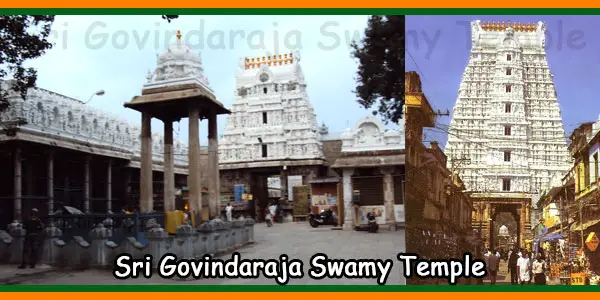
Govindaraja Temple Timing
Sri Govindaraja Swamy Temple is open to visitors throughout the year, with the best time to visit being during the winter months from November to February when the weather is pleasant. The temple is located in the heart of Tirupati, and visitors can reach it easily by road or rail. The temple opens its doors to devotees at 5:30 AM and closes at 9:00 PM.
Festivals
Sri Govindaraja Swamy Temple celebrates several festivals throughout the year, attracting devotees from all over the country. Some of the popular festivals celebrated at the temple include Vaikuntha Ekadasi, Brahmotsavam, and Janmashtami. During these festivals, the temple is decorated with flowers and lights, and special poojas and rituals are performed.
Poojas Performed
Several poojas are performed at Sri Govindaraja Swamy Temple every day to appease Lord Vishnu and seek his blessings. Some of the popular poojas include Suprabhatam, Thomala Seva, Archana, and Ekantha Seva. Devotees can also perform special poojas and rituals by booking in advance.
Sri Govindaraja Swamy Temple History
Sri Govindaraja Swamy Temple has a rich history dating back to the 12th century. The temple was built during the reign of the Chola dynasty and was expanded during the Vijayanagara dynasty. The temple is considered to be one of the most important pilgrimage sites in South India and is visited by thousands of devotees every day.
6) ISKCON Tirupati
ISKCON Tirupati, also known as Sri Sri Radha Govinda Mandir, is a popular temple in the town of Tirupati, Andhra Pradesh. The temple is part of the International Society for Krishna Consciousness (ISKCON) and attracts devotees from all over the world. In this article, we’ll provide you with a guide to timing, festivals, and activities at ISKCON Tirupati.

Timing
ISKCON Tirupati is open to visitors throughout the year, with the best time to visit being during the winter months from November to February when the weather is pleasant. The temple is located in the heart of Tirupati, and visitors can reach it easily by road or rail. The temple opens its doors to devotees at 5:30 AM and closes at 9:00 PM.
Festivals
ISKCON Tirupati celebrates several festivals throughout the year, attracting devotees from all over the country. Some of the popular festivals celebrated at the temple include Janmashtami, Radha Ashtami, and Gaura Purnima. During these festivals, the temple is decorated with flowers and lights, and special poojas and rituals are performed.
Activities
ISKCON Tirupati offers several activities for devotees and visitors alike. The temple has a bookshop that sells books on spirituality and religion, and devotees can purchase souvenirs and other items from the gift shop. And also serves Prasadam, a sacred food offered to Lord Krishna, which visitors can enjoy at the temple’s restaurant.
The temple also offers classes on Bhagavad Gita and other spiritual topics, and devotees can participate in kirtans, which are musical performances that involve chanting and singing devotional songs.
ISKCON History
ISKCON Tirupati was established in 1984 and is part of the ISKCON movement, which was founded by His Divine Grace A.C. Bhaktivedanta Swami Prabhupada in 1966. The temple is dedicated to Lord Krishna and is known for its beautiful architecture and serene surroundings.
7) Vakula Matha Temple
The Temple of Vakula Devi, constructed about 300 years ago on Peruru banda hillock, stands as a beautiful symbol of the mother-son relationship and maternal love, epitomized in the life of Lord Venkateswara. Situated in Perur village, only 10 kilometers from the Tirumala hills and 5 kilometers from Tirupati, the temple spans over 50 acres of stunning landscape. As per Vakula maatha’s wishes, the temple was built in a manner that allows her visage to face the Seven Hills, the dwelling place of her beloved son, Lord Venkateswara.

8) Chandragiri Fort and Palace
Chandragiri Fort is a historical fort located in the town of Chandragiri in Andhra Pradesh. The fort is a popular tourist destination and attracts visitors from all over the country. In this article, we’ll take a closer look at Chandragiri Fort and explore its historical significance and popular attractions.
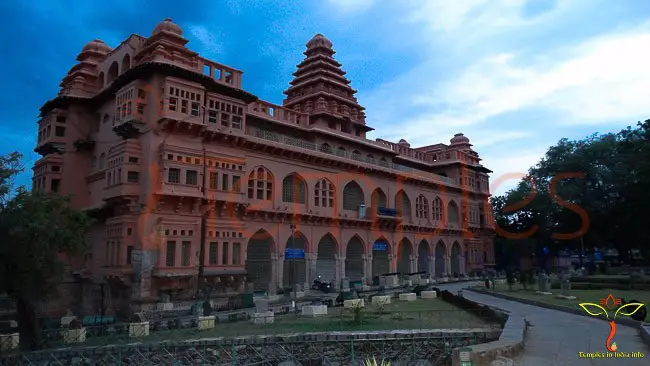
History
Chandragiri Fort has a rich history that spans over several centuries. The fort was built in the 11th century by the Yadava Naidu rulers and was later renovated by the Vijayanagara Empire in the 14th century. This was also the capital of the Vijayanagara Empire for a brief period before the empire fell to the Deccan Sultanates in the 16th century. The fort was later occupied by the Mughal Empire and the British before being turned over to the Andhra Pradesh government in 1962.
Attractions
Chandragiri Fort is a popular tourist destination and is known for its beautiful architecture, stunning views, and rich history. Some of the popular attractions at the fort include:
- Raja Mahal: Raja Mahal is a beautiful palace located inside the fort that was once the residence of the Vijayanagara Empire’s kings. The palace is known for its intricate carvings, beautiful architecture, and stunning views.
- Museum: The museum at Chandragiri Fort is home to several artifacts and relics from the Vijayanagara Empire, including weapons, jewelry, and clothing.
- Viewpoints: The fort offers several viewpoints that provide breathtaking views of the surrounding area, including the famous Tirumala Hills.
Timing and Entry Fee
Chandragiri Fort is open to visitors from 9:00 AM to 5:00 PM every day, and the entry fee is Rs 45/- (Adult) Rs 35 for 5 to 12 years (Child) below.. Visitors can also hire a guide to explore the fort and learn more about its history and significance.
9) Sri Venkateswara Zoological Park
Sri Venkateswara Zoological Park, located in Tirupati, Andhra Pradesh, is a sprawling 5532-acre wildlife sanctuary that houses a diverse range of flora and fauna. The park is named after Lord Venkateswara, the presiding deity of the renowned Tirumala Venkateswara Temple located nearby.
Established in 1987, the park is one of the largest zoological parks in Asia and is home to over 2,000 animals belonging to over 150 species. Visitors can witness a variety of animals, including tigers, lions, elephants, zebras, giraffes, and many more.

The park is divided into two zones, the Safari Park and the Nocturnal Animal House. The Safari Park is spread across 550 acres and offers a unique experience of viewing animals in their natural habitat. Visitors can take a guided tour on a safari vehicle or a battery-operated vehicle to see animals like tigers, lions, bears, deer, and many more.
The Nocturnal Animal House is an exclusive exhibit of nocturnal animals, allowing visitors to observe animals that are active during the night, such as owls, bats, and nightjars. Visitors can see these animals in their natural environment, simulating night-time conditions, and learn about their behavior and habitat.
In addition to the Safari Park and Nocturnal Animal House, the park has several other attractions such as a bird park, reptile park, and a butterfly park. Visitors can also enjoy a toy train ride, a boating experience in the park’s lake, and a rope bridge adventure.
Conservation and Research
The park is committed to conservation efforts and has undertaken several initiatives to protect endangered species. It also provides a research center for students and scholars to study wildlife and biodiversity.
Accommodation and Food
The park has comfortable guesthouses for visitors to stay in and enjoy the wilderness. The cafeteria offers a variety of food and beverages to satisfy visitors’ taste buds.
10) Regional Science Centre
Tirupati Regional Science Centre is a premier science museum located in Tirupati, Andhra Pradesh. The center is designed to provide a hands-on learning experience for visitors of all ages, inspiring them to learn and explore the wonders of science.
The center offers a range of interactive exhibits, displays, and activities that showcase various aspects of science and technology. The exhibits are designed to be engaging and informative, providing visitors with a fun and educational experience. Some of the popular exhibits include the planetarium, the mirror magic exhibit, the electricity exhibit, and the sound and light exhibit.

The planetarium is a highlight of the center, offering a breathtaking view of the night sky, complete with stars, planets, and constellations. The mirror magic exhibit is an interactive exhibit that allows visitors to explore the properties of reflection and refraction. The electricity exhibit demonstrates the basics of electricity, including generation, transmission, and distribution. The sound and light exhibit highlight the properties of sound and light waves.
The center also offers a range of educational programs, including workshops, seminars, and summer camps. These programs are designed to provide an in-depth understanding of various scientific concepts and principles, making learning a fun and enriching experience.
In addition to the exhibits and programs, the Tirupati Regional Science Centre has a well-equipped library, providing visitors with access to a vast collection of scientific books, journals, and magazines. The library also offers online access to scientific databases and other resources, making it a valuable resource for students, researchers, and science enthusiasts.
The center is open to visitors throughout the year, and admission is free. The center is easily accessible from Tirupati and other nearby cities, making it an ideal destination for families, school groups, and science enthusiasts.
